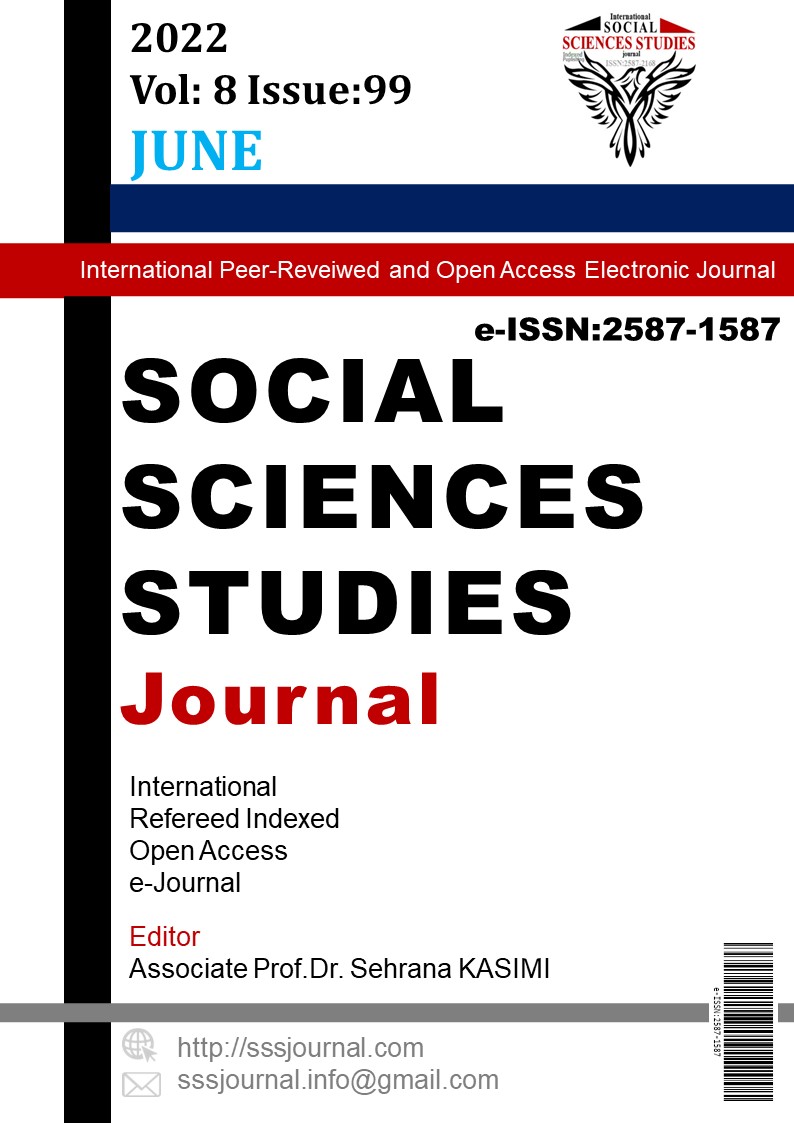Author :
Abstract
Keywords
Abstract
The study aims to determine the status of digital addiction among university students during the COVID-19 pandemic. Between February and April 2021, a total of 1036 university students from Çankırı Karatekin University and Kütahya Dumlupınar University students who voluntarily agreed to participate in the study participated in the cross-sectional descriptive study. An Introductory Information Form and a Digital Addiction Scale were used in the research. Individual consent were obtained from the participants and the data were collected with the Google form link. The data analysis used t-tests for independent groups and ANOVA tests for multiple groups. The mean age of the students participating in the study was 20.25±1.88. 79.5% of the students were girls, and 45.1% were first-year students. The mean score of the Digital Addiction Scale for the students was 76.44±19.676, the mean score of the game sub-dimension score was 20.53±8.336, the mean score of the social media dimension was 37.36±9.737, and the mean score of the effect on social life dimension was 18.54±6.791. Digital addiction was found to be statistically significant higher in male than in female. While digital addiction was high in the male gender in the game sub-dimension, it was higher in the female gender in the social media sub-dimension. The time spent by the students on the internet outside the course after pandemic increased according to before pandemic. As the daily on the internet outside the course use time increased, the digital addiction score increased. The increase in digital addiction, one of the biggest dangers brought by the developing technology, raises the concern of being a risk for future generations.
Keywords
- Aktan, E. (2018). "Üniversite öğrencilerinin sosyal medya bağımlılık düzeylerinin çeşitli değişkenlere göre
- Aktan, E. (2018). "Üniversite öğrencilerinin sosyal medya bağımlılık düzeylerinin çeşitli değişkenlere göre incelenmesi", Erciyes İletişim Dergisi, 5(4), 405-421.
- Aljomaa, S. S.; Qudah, M. F. A.; Albursan, I. S.; Bakhiet, S. F. & Abduljabbar, A. S. (2016). "Smartphoneaddiction among university students in the light of some variables", Computers in Human Behavior, 61, 155-164.
- Arslan, A. (2019a). "Ortaöğretim öğrencilerinin dijital bağımlılık düzeylerinin çeşitli değişkenler açısından incelenmesi: Sivas ili örneği", Gazi Eğitim Bilimleri Dergisi, 5(2): 63-80.
- Arslan, A. (2019b). "Üniversite Öğrencilerinin Dijital Bağımlılık Düzeylerinin Çeşitli Değişkenler Açısından İncelenmesi", International e-Journal of Educational Studies, 4 (7): 27-41.
- Arslan, A.; Kırık, A.; Karaman, M. & Çetinkaya, A. (2015). "Lise ve üniversite öğrencilerinde dijital bağımlılık". Uluslararası Hakemli İletişim ve Edebiyat Araştırmaları Dergisi, 8(8): 34-58.
- Bağcı, H. (2019). "Analyzing the digital addiction of university students through diverse variables: example of vocational school", International Journal of Contemporary Educational Research, 6(1): 100-109.
- Bağımlılıkla Mücadele Yüksek Kurulu, https://bmyk.gov.tr/TR-67179/bagimlilik-nedir.html, Erişim Tarihi: 15.03.2022
- Balcı, Ş. & Gülnar, B. (2009). "Üniversite öğrencileri arasında internet bağımlılığı ve internet bağımlılarının profili", Selçuk İletişim, 6(1): 5-22.
- Barreto, S. & Adams, S. K. (2011). "Digital technology and youth: A developmental approach". The Brown University Child and Adolescent Behavior Letter, 27(6): 3-6.
- Besalti, M., & Satici, S. A. (2022). "Online learning satisfaction and internet addiction during Covid-19 pandemic:A two-wave longitudinal study". TechTrends: for Leaders in Education & Training, 1-7. Advance online publication.
- Demirdel, E.; Aşkın, B. G.; Çıtlak, B. & Zorlu, F. Z. (2021). "Madde Bağımlılığı Tedavisinde Egzersiz", Türkiye Sağlık Araştırmaları Dergisi, 2(2): 51-62.
- Eryılmaz, S. & Çukurluöz, Ö. (2018). "Lise Öğrencilerinin Dijital Bağımlılıklarının İncelenmesi: Ankara İli, Çankaya İlçesi Örneği", Elektronik Sosyal Bilimler Dergisi, 17(67): 889-912.
- Gómez-Galán J.; Martínez-López J. Á.; Lázaro-Pérez C. & Sarasola Sánchez-Serrano J. L. (2020). "Socialnetworks consumption and addiction in college students during the COVID-19 pandemic: Educational Approach to Responsible Use". Sustainability. 12(18): 7737.
- Gómez-Galán, J.; Lázaro-Pérez, C. & Martínez-López, J. (2021). "Exploratory study on video game addiction ofcollege students in a pandemic scenario". Journal of New Approaches in Educational Research, 10(2): 330-346.Karaca, A.; Demirci, N.; Caglar, E. & Unlu, H. K. (2021). "Correlates of internet addiction in Turkish adolescents", Children and Youth Services Review, 126, 106050.
- Meng, S. Q.; Cheng, J. L.; Li, Y. Y.; Yang, X. Q.; Zheng, J. W.; Chang, X. W.; Shi, Y.; Chen, Y.; Lu, L.; Sun, Y.;Bao, Y. P. & Shi, J. (2022). "Global prevalence of digital addiction in general population: A systematic review and meta-analysis". Clinical Psychology Review. 92: 102128.
- Ögel, K. (2001). İnsan, yaşam ve bağımlılık: Tartışmalar ve gerekçeler, IQ Kültür Sanat Yayıncılık, İstanbul, 1-20.T.C. Sağlık Bakanlığı, Uyuşturucu ile Mücadele Danışma ve Destek Hattı, Erişim Tarihi: 15.03.2022, https://alo191.saglik.gov.tr/TR-21183/bagimlilik-nedir.html
- TDK, Türk Dil Kurumu Sözlükleri, https://sozluk.gov.tr/ , Erişim Tarihi: 15.03.2022
- Topal, T. (2021). "Investigation of high school students internet addiction levels using various variables: The case of Giresun Province", Educational Research and Reviews, 16(1): 1-8.
- Ungaro, H. C.; Do Amaral, F. V.; Abe, J. M.; Tomiatti, L. H. D. C. & Nakamatsu, K. (2018). "An Analysis ofDigital Dependence in Dissonance with People’s Perception of Digital Dependence in Companies". International Journal of Internet of Things and Web Services, 3: 61-66.
- US Psikiyatri Enstitüsü. Erişim Tarihi: 20.03.2022 https://www.uspsikiyatri.com.tr/Bagimlilik/Davranissal_Bagimliliklar/
- Young, K. S. (1998). "Internet Addiction: The Emergence of a New Clinical Disorder". Cyberpsychology & Behaviorvol. 1 (3): 237-244.
- Yurdakoş, K. & Biçer, E. B. (2019). "İnternet bağımlılık düzeyinin akademik ertelemeye etkisi: Sağlık yönetimi öğrencileri üzerine bir araştırma", Yüzüncü Yıl Üniversitesi Eğitim Fakültesi Dergisi, 16(1): 243-278.





